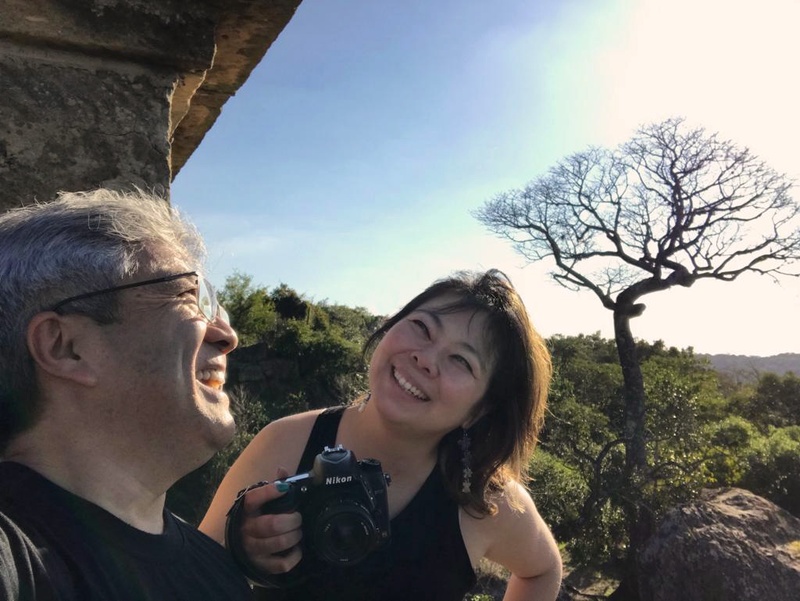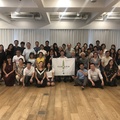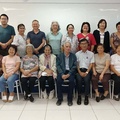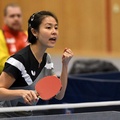We know that many Japanese came to Brazil over 100 years ago. They brought their culture with them, which their descendants preserve, but at the same time, it has evolved over time. One part of this culture’s customs is the celebrations. So, I talked with two professionals who work in production and photography for celebrations and other events.
“I have always had, since childhood, a very big interest in sound and music. Encouraged by my mother, I attended cultural events at the Piedade kaikan [local association in Sao Paulo state], my hometown. When I started attending electronics technology school, I was sure I liked sound producing. With maturity, already knowing a little about good equipment, I think I became a little demanding regarding the equipment of Nikkei community events. I then went in search of resources. Finally, in 1989, I had the first opportunity to be hired for an event of our community”, says Alceu Atsushi Abe, Nisei, partner in Dai Pro Events, a company with just over 30 years in business.
Eliane Mitie Tamada, Sansei, Atsushi's wife, works as a photographer in her own company and also helps her husband in events. “When I was a kid, about seven, I asked Santa Claus for a camera. I got a Kodak Instamatic and spent all of my little allowance developing films. I would love to take pictures of myself (there were no selfies, I would take a photo by guesstimate) and of my dolls. I shot the marriage ceremony of my teddy bears (laughs)”, recalls Mitie.
The interest in photography, however, was not immediately a job option. As with many families (Nikkei and non-Nikkei), the family exerts some pressure. “At that time, there were not as many professions as today, and photography was not an option. My parents' dream was that I would be a lawyer like my brother or something computer related. It took attending two colleges at the same time for a year for me to choose one because I still didn't know what I liked more (or less). I only went back to photography when I was working in the IT industry; With the company's digital camera, I shot internal events, because coincidentally the camera was passed to me. I realized that I really liked being behind the camera”, says Mitie.
Recommendations
A celebration assumes the presence of close people, such as friends and family. Thus, hiring professionals to work at the event requires special attention. In situations like this, recommendations are very valuable. In this point, the Nikkei community still shows influence. “About 5% of all events are outside the Nikkei community. Even so, that 5% comes from Nikkei recommendations. We are an emerging community, always with hard work and energy. I see it in every family I know. This recognition makes us respect each other and sympathize,” explains Atsushi.
The range of events in which Atsushi and Mitie work is quite extensive. There are weddings, music shows, children's and debutante balls, weddings, lectures, and many others.
With so much experience, both observe changes in the Nikkei celebrations in Brazil. “In the past, presenters, masters of ceremony and even those who would make a speech used the Japanese language as standard and a short translation into Portuguese. Over time, this has been reversed, and today I see that the vast majority adopt the Portuguese language as standard and sometimes a short Japanese translation”, says Atsushi.
Mitie points out a change related to the songs requested to play during the parties. “Before, they didn't want to play a lot of Japanese music because of non-Nikkei guests. Currently, I've seen requests to play Japanese rock songs, and all the guests enjoy it! I think this change is happening thanks to the internet, lots of games and anime, along with music, shows, and typical foods.”
Japanese food is an element that Nikkei rarely leave out of celebrations. Sushi and sashimi are almost ubiquitous.
“One change is that, in the past, the hosts themselves did everything: they cooked and served the guests, made benches with long wooden boards, covered with red paper. The guests ate, drank and went back home. Today, they hire buffets specialized in Japanese cuisine, decorators, shows with singers and bands from the community, taiko, DJs, lighting and big screens to entertain the guests”, says Atsushi.
“There were times when I felt that the Nikkeis were moving away from our roots, but fortunately we are once again proudly spreading our culture, so much that many non-descendants enjoy our food, arts, music, clothing etc.”, says Atsushi.
“I think that the beliefs and traditions have been valued and sought lately. The use of kimono in wedding ceremonies, for example, has been increasing, from the kimono specific to an occasion to the more stylized one. Even in the ceremonies, even if not for religious reasons, I have seen grooms choose to perform the sake ceremony because they find it beautiful or to pay tribute to an ancestor”, says Mitie.
Family portraits
At celebrations in my own personal family, there is almost always a time when someone says, "Let's take a picture." Then everyone is positioned in rows, someone sets the camera's timer, and the family picture is done, which will eventually be placed in a frame. A Nikkei home usually has many of these family portraits.
“I really like spontaneous photos,” says Mitie, “but I think these posed photos are also very important. In families of all origins they are asked for, and if not, I remind them to do so, because time does not go back and we have to be proud of our family. I think it’s very important to take pictures of parents with children, grandparents with grandchildren... I usually ask them to hug, because the vast majority of Japanese don’t often show affection. So parties are great opportunities to break this ice and embrace your loved one,” she adds.
“I love listening to stories and also telling them. I work on editing photo memory videos too, and I think the whole story of the immigrants’ endurance and thriving is really cool. I am proud of our ancestors. I am very happy to see that more and more customs are being respected,” says Mitie.
“In addition to weddings, I work a lot in celebrations, such as birthdays and silver and gold wedding anniversaries, in which I make sure to spread Japanese culture through storytelling from each client, often they had experienced difficult times in Japan themselves, the war, immigration, adaptation to a new nation,” says Atsushi.
“At the time of the dekasegi boom [the mid-1980s and 1990s] I felt that the Nikkei were moving away from our roots. Many kaikans stopped activities for lack of participants, especially those related to Japanese customs such as baseball, gateball, Nihongo, odori, singing, karaoke etc ... It was a very difficult time, because the most requested age group for dekasegis was precisely the one who put the kaikans in movement. After this phase, I saw that many returned bringing new stories from Japan, renewing the kaikans and spreading the culture and encouraging children and teenagers to attend nihon gakko, and today I surprisingly see many young people reading, writing and speaking fluently Nihongo. I am glad to see even non-descendants risking one line or another in Japanese. I am glad to see Japanese food restaurants packed with non-descendants. I am happy to see children and non-descendants participating in taiko groups, typical dances, karaoke... I am Brazilian, but I think my kokoro is Japanese!”, Atsushi adds.
© 2019 Henrique Minatogawa






